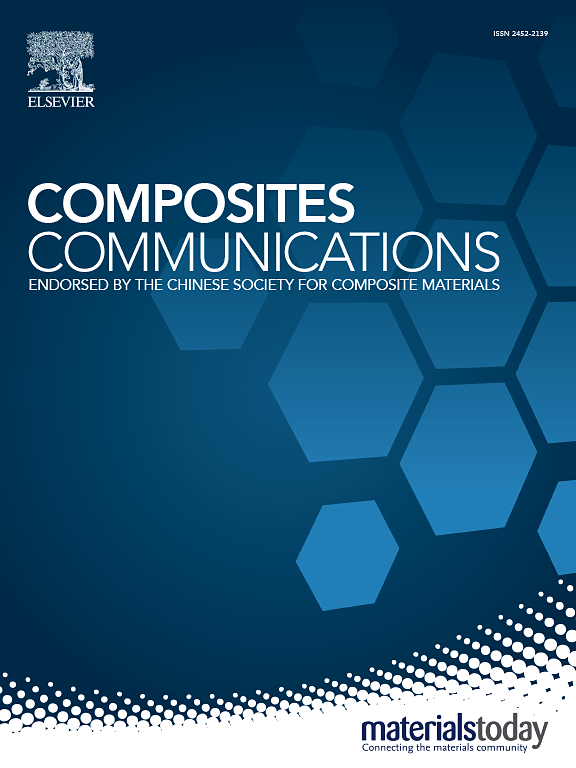机织全C/C复合材料蜂窝夹层结构近零面内热膨胀性能的多尺度设计
IF 7.7
2区 材料科学
Q1 MATERIALS SCIENCE, COMPOSITES
引用次数: 0
摘要
碳/碳蜂窝夹层结构是超稳定卫星平台的理想解决方案。实现其应用的关键是实现考虑不同水垢特性的近零热膨胀设计。本研究建立了跨微观-中观-宏观水平的多尺度有限元模型来预测碳/碳蜂窝夹层结构的热膨胀行为,对复合材料和夹层结构的预测误差分别为11.03%和12.01%。在多尺度模型的基础上,对织造图案和结构尺寸进行了优化。中尺度模式预测分析表明,对称型平纹编织碳/碳复合材料具有较低的热应变和较好的热稳定性。随着椭圆截面束展开比的增大,复合材料的负热应变进一步减小。因此,确定了细胞壁和面板的编织结构。根据宏观尺度模型预测,确定了C/C夹层结构的最佳面板厚度、胞壁厚度和胞长组合为(1.5 mm、0.4 mm、3mm)、(1.5 mm、0.4 mm、5mm)和(3 mm、0.2 mm、3mm)。另外,上述夹层结构的粘接层厚度配置分别为1.18 mm、0.92 mm和0.74 mm,从而实现了夹层结构的面内零热膨胀。综上所述,通过多尺度分析对织物图案和几何参数进行优化,实现了碳/碳蜂窝夹层结构的零热膨胀系数设计。本文章由计算机程序翻译,如有差异,请以英文原文为准。
Multi-scale design of the near-zero in-plane thermal expansion property of the woven all-C/C composite honeycomb sandwich structure
The carbon/carbon honeycomb sandwich structure is an ideal solution for ultra-stable satellite platforms. The key to realize its application is to realize near zero thermal expansion design with consideration of different scale characteristics. This study establishes a multi-scale finite element model spanning micro-meso-macro levels to predict thermal expansion behavior of carbon/carbon honeycomb sandwich structures, achieving prediction errors of 11.03 % to the composite and 12.01 % to the sandwich structure. Based on the multi-scale model, optimizations are conducted for weaving patterns and structural dimensions. Analysis of the meso-scale model prediction shows that symmetric plain-woven carbon/carbon composites exhibit superior thermal stability with low thermal strain. When the spreading ratio of elliptical cross-section bundles is increased, the negative thermal strain of the composite is further reduced. Hence, weave structures of the cell wall and the panel are determined. Furthermore, optimal panel thickness, cell wall thickness and cell length combinations of the C/C sandwich structure are identified of (1.5 mm, 0.4 mm, 3 mm), (1.5 mm, 0.4 mm, 5 mm), and (3 mm, 0.2 mm, 3 mm) according to the macro-scale model prediction. Additionally, the configuration of the adhesive layer thickness of the above sandwich structures as 1.18 mm, 0.92 mm, and 0.74 mm respectively consequently achieves the in-plane zero thermal expansion of the sandwich structure. In summary, the zero thermal expansion coefficient design of carbon/carbon honeycomb sandwich structures is achieved through optimization of textile patterns and geometric parameters by multi-scale analysis.
求助全文
通过发布文献求助,成功后即可免费获取论文全文。
去求助
来源期刊

Composites Communications
Materials Science-Ceramics and Composites
CiteScore
12.10
自引率
10.00%
发文量
340
审稿时长
36 days
期刊介绍:
Composites Communications (Compos. Commun.) is a peer-reviewed journal publishing short communications and letters on the latest advances in composites science and technology. With a rapid review and publication process, its goal is to disseminate new knowledge promptly within the composites community. The journal welcomes manuscripts presenting creative concepts and new findings in design, state-of-the-art approaches in processing, synthesis, characterization, and mechanics modeling. In addition to traditional fiber-/particulate-reinforced engineering composites, it encourages submissions on composites with exceptional physical, mechanical, and fracture properties, as well as those with unique functions and significant application potential. This includes biomimetic and bio-inspired composites for biomedical applications, functional nano-composites for thermal management and energy applications, and composites designed for extreme service environments.
 求助内容:
求助内容: 应助结果提醒方式:
应助结果提醒方式:


